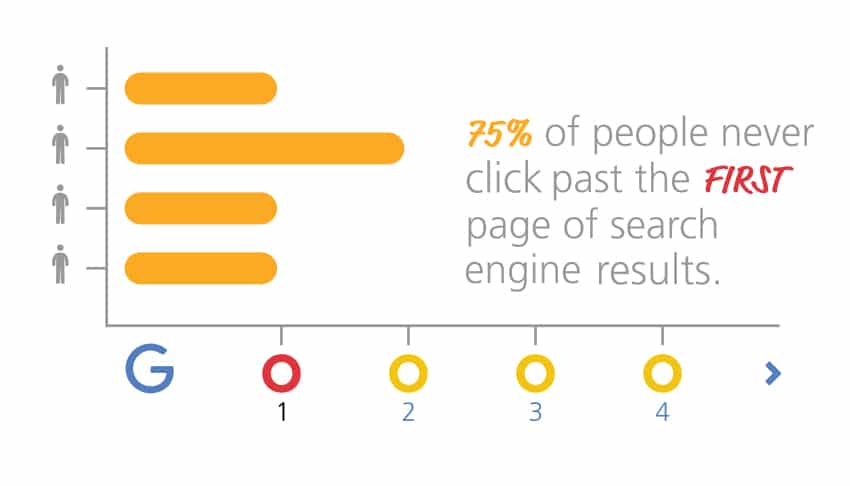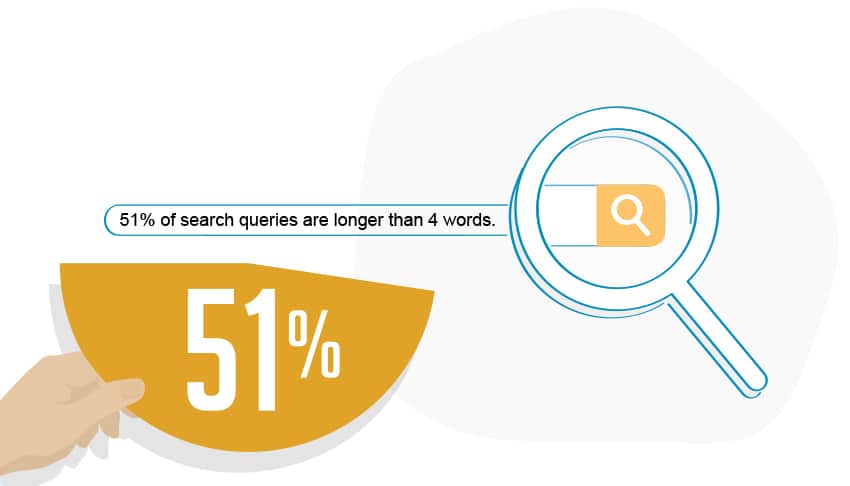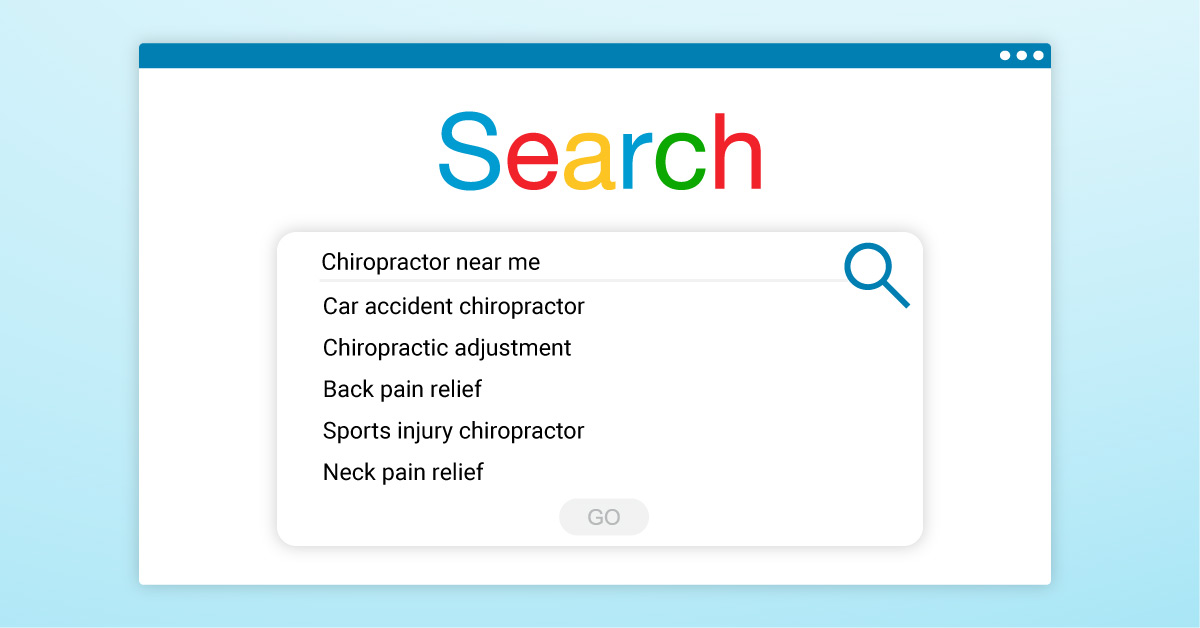Improve Your Practice’s Google Ranking With These 5 Solutions

Showing up on Google’s first page can do wonders for your business. The higher your page is able to rank for related keyword search queries, the better chance you have of attracting new patients or clients to your practice.
The cold, hard truth of the matter is that the majority of people don’t click past the first page of Google’s search results. Research suggests that about 75% of people never click past the first page and 67% of those clicks go to the first five results. This means that it’s vital for your website to be one of those results!
Not only does topping Google’s first page improve your online visibility, it also increases web traffic to your site, boosts brand recognition within your community, and provides more opportunities to turn clicks into clients or patients.
Do a quick Google search of keywords related to your practice, such as “optometrist in Bozeman, Montana”, “chiropractic sports medicine Dallas”, or “mobile equine veterinarian near me”. Don’t search for your practice name, as the majority of new patients or clients will not be searching for you specifically by name.
Does your website appear on the first page? Is your website on the first page, but not ranking above your biggest competitors? Don’t worry, you can change that.
In this article, we will teach you how to identify common problems that could be affecting your ranking and how to remedy those problems so you get your site on Google’s first page.
Why Isn’t My Website Showing Up on Google?
Whether your website appears at the bottom of the first search engine results page (SERP) or is relegated to the third page of results, there are steps you can take to improve your Google ranking. Let’s go over some of the most common mistakes we see businesses making on their websites and how to fix these issues.

Problem #1: Your web pages are not indexable.
Search engine optimization, better known as SEO, describes a group of marketing strategies used to increase the amount and quality of organic traffic to your website. Popular SEO strategies include keyword research, link building, content marketing, as well as technical and on-site SEO.
One of the most fundamental strategies of SEO is to create indexable pages. Google’s algorithm crawls sites in order to collect and categorize information so that when a web user enters a search, the algorithm can go into its virtual file cabinet to pull websites that meet the user’s needs. In order for the algorithm to find your web pages, they need to be indexable.
Solution: Audit your web pages to make sure they are indexed.
To check if your content is indexed on Google, plug URLs into the search bar to see if they populate in SERPs. If your web page doesn’t come up, then you know that Google has yet to index that page.
We’re not going to lie, creating crawlable pages is not the easiest task. Typically, your website designer will handle this problem. Contact your site manager and address this problem immediately so that your pages can get found by Google’s algorithm.
Problem #2: Your content is not keyword optimized.
Keyword optimization is the act of researching, selecting, and implementing keywords into digital content to drive more relevant traffic to a website. Targeting the right keywords can help you attract potential patients or clients looking for services like yours.
Solution: Research and implement keywords.
Keywords can be used in content, meta titles, meta descriptions, and alt tags to signal to Google’s algorithm that a particular web page relates to search queries that feature similar keyword phrases. Use the following tips to successfully implement keywords onto your website:
- Understand how your audience is searching for your business and target keyword phrases they use most.
- Utilize Google’s autocomplete feature to identify popular search terms.
- Invest in a keyword research tool, such as Moz or Wordstream, to view data on search terms. These tools can help you identify which keyword phrases it would be easiest for your website to rank for.
- Beware of generalized search terms. You are less likely to rank for “chiropractic care” than you are for “personal injury chiropractic care”.
- Include keyword phrases in meta titles and descriptions to appeal to Google’s algorithm.

Problem #3: Your website isn’t optimized for mobile.
Google practices mobile-first indexing. This means that mobile-responsive websites are prioritized over desktop sites when the search stems from a mobile device. This means that your website may not appear on searches made on a smartphone or tablet if you fail to optimize for mobile.
It’s not just the algorithm that discriminates against desktop sites for mobile. Smartphone users are quick to leave sites that are difficult to navigate on mobile. This will increase your bounce rate, which will then negatively impact your search engine ranking.
Solution: Design a mobile-responsive website.
Luckily, most website hosts enable you to design a site that looks as good on mobile as it does on a desktop. If you went through a web designer that made your site from scratch, be sure to ask them whether or not your web pages are mobile-friendly. The designer will need to adjust components, such as images and code, to meet mobile standards.
Problem #4: You aren’t regularly updating your content.
When is the last time you added a new piece of content to your website? If the answer is longer than a few weeks, it’s time to get to writing! Google wants to see consistent, quality content that provides value to web users.

Solution: Create quality content.
Please note that the keyword here is quality. Both web users and Google’s algorithm will be able to sniff you out if you are only updating your content to stuff web pages with keywords or to attract the maximum amount of clicks.
The goal of your content should be to provide users with value. This could be through content such as educational articles, informational videos, and entertaining posts.
Pro Tip: The average length for high ranking content is approximately 1,200 words.
A good way to continually add content to your website is to start a blog! Blogs enable you to write content that addresses common pain points so that your audience begins to see your practice as an authority within your industry. This also gives you an opportunity to target keywords that can generate interested clicks on your website.

Problem #5: Your site has a poor user experience.
User experience, also known as UX, describes the quality of the experience a person has with a website, product, or service. This can encompass components like page speed, site architecture, and accessibility of web pages. Poor user experience can contribute to your bounce rate, or the percentage of people that go onto your site then quickly navigate off of it.

Solution: Look at your website from an unbiased perspective.
When web users click onto your site, they want to find the information they’re looking for as quickly as possible. Slow page speed, confusing navigation bars, and pixelated content can prevent users from staying on your site long enough to find that information, let alone convert into a patient or client.
We know it’s hard to audit your site from an unbiased perspective, so you may want to enlist in a friend or colleague to tour your site with fresh eyes. Ask them to find various pages on your site without telling them how to navigate to those pages. If they are unable to locate them, then you know that your target audience probably can’t either.
How to Rank Higher on Google
The strategies discussed in this article are some of the top ranking factors Google uses to determine which pages rank on SERPs, We suggest using this list as a starting point to help you assess the effectiveness of your website and SEO strategy.
Rank higher on Google with these additional resources
How to Implement SEO on Your Website
What You Need to Know About Technical SEO
Better Your Google Ranking and Get Found Online




